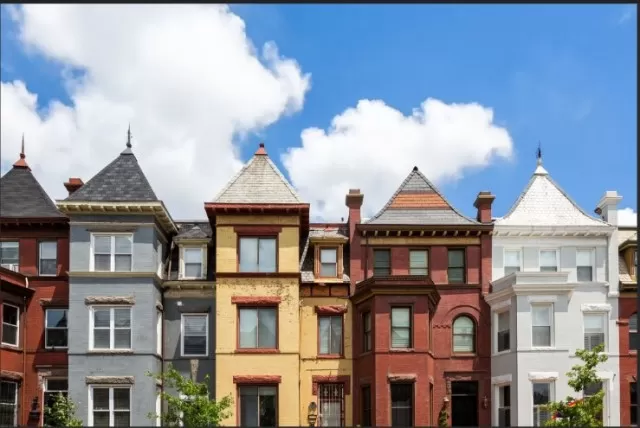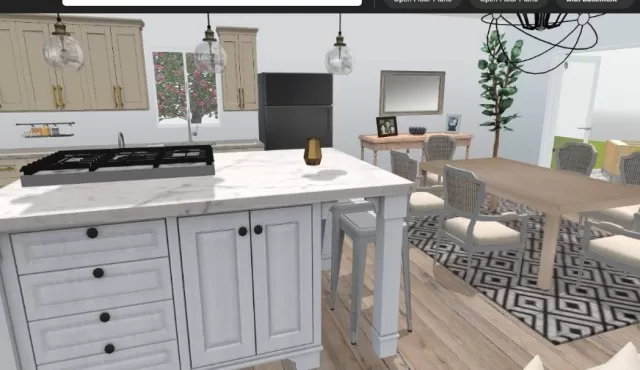Unexpected Design Trends Post-Pandemic: Surprises Await. In the wake of the sweeping coronavirus pandemic, our lives have undergone a profound metamorphosis, reshaping the very fabric of our daily existence. Yet, amid the challenges, a fascinating evolution has unfolded within the realm of home design. From the cocooning cocoon of our abodes, innovative trends have emerged – unexpected, yet harmoniously synchronized with the new rhythms of our lives.
As we explore this enchanting narrative, we uncover the emergence of dedicated entertainment spaces, born from the necessity of finding solace within our own four walls. No longer confined to fleeting escapes, our homes have become theaters of leisure and recreation. The once-generic corners now transform into curated havens of entertainment, where cinematic experiences and immersive gaming adventures find their stage, enveloped in a cocoon of comfort and familiarity.
Yet, the transformation is not confined to entertainment alone. The hues that grace our walls have evolved into more than just aesthetic choices; they now wield the power to shape our emotional landscapes. Paint colors, once mere adornments, have metamorphosed into conduits of tranquility and serenity. Soft palettes and earthy tones now adorn our sanctuaries, offering solace and respite from the turbulence beyond our doors. It is a symphony of design that resonates with the innate human longing for calm amidst chaos.
The Transformative Influence of the Pandemic on Residential Spaces: Reshaping Homes for Enhanced Living

Amidst the pandemic’s enduring impact, a significant shift has occurred in the way we perceive and utilize our living spaces.
With the world’s circumstances prompting an unprecedented surge in time spent at home, homeowners have responded with ingenious adaptations that not only accommodate this new reality but elevate it. From expansive renovations that create additional room to ingenious modifications maximizing existing space, individuals have harnessed their creativity to navigate the evolving demands of home life.
In this exploration of pandemic-induced design trends, we uncover nine remarkable shifts that have redefined the modern household.
These trends not only boost efficiency and functionality but also inject an element of delight and relaxation into our everyday lives. From multifunctional workspaces that seamlessly merge professional and personal spheres, to indoor havens that blur the line between recreation and relaxation, these adaptations offer a glimpse into the future of home design.
As we traverse the implications of these changes, one thing becomes clear: the pandemic has spurred a renaissance in how we view our homes.
No longer merely a physical shelter, they have morphed into dynamic and adaptable environments that cater to our ever-evolving needs. So, whether you find yourself nestled in a cozy apartment or sprawling across a spacious suburban abode, these pandemic-born design trends promise to revolutionize your living experience, enticing you to fully embrace the joys of home.
As the world inches towards a new normal, the question lingers—could our homes become more than just a refuge? Could they become our ultimate sanctuary, a place where we not only live but thrive?.
Reshaping Priorities: The Downsizing Dilemma in a Post-Pandemic Landscape
Before the pandemic’s upheaval, the allure of compact living and the minimalist philosophy were sweeping through the housing scene, captivating individuals with the notion that less could indeed be more.
However, as the world plunged into lockdowns and the need for social distancing took root, the once-thriving downsizing trend encountered an unexpected deceleration. The very concept of streamlining living spaces began to shift as a new reality emerged—one that emphasized the necessity for increased square footage.
A metamorphosis was evident, as families adapted to the challenges of remote work and virtual learning.
The confines of smaller residences no longer sufficed; the demand for expansiveness became palpable. The transition of family members into the realm of remote employment and education led to a pressing requirement for additional rooms that could guarantee privacy and solitude.
Lofts, basements, garages—these erstwhile storage spaces found new purpose as they transformed into habitable havens, accommodating the evolving needs of a household in flux.
Jean Brownhill, the visionary mind behind Sweeten, a platform that harmonizes homeowners with reputable contractors, offers keen insights into this shifting paradigm.
Brownhill observes that for those unable to embark on grand expansions, a trend has emerged—the ascent of interior sliding doors. These dynamic installations have swiftly ascended in popularity, serving as a versatile solution to swiftly carve out new spaces within existing ones, adding a layer of adaptability to the home environment.
Amidst these transformations, a pertinent question arises: Can the allure of downsizing weather the storm brought by the pandemic’s wake? As the boundaries of work, learning, and leisure continue to intertwine within our abodes, the very notion of an ideal living space evolves.
Balancing the charm of a compact existence with the pragmatic demands of a post-pandemic world is the new challenge. With interior sliding doors serving as a visual metaphor for this adaptability, the concept of home is poised for a renaissance—a fusion of space, function, and innovation that navigates the shifting tides of our times.
\”Elevated Outdoor Oasis: The Evolution of Home Exterior Spaces in the Pandemic Era\”

In the wake of the pandemic’s transformative impact, a notable shift has taken root—one that has extended the boundaries of our homes to encompass the great outdoors.
As families found themselves nestled within the embrace of their abodes for extended periods, a natural inclination emerged to expand and enhance their living experiences beyond conventional interiors. In this paradigm shift, the allure of outdoor spaces has taken center stage, emerging as sanctuaries of solace and avenues of recreation.
Against this backdrop, a resounding narrative echoes through the corridors of design firms across the globe.
The year 2020 bore witness to a profound surge in demand, driven by a collective desire to transform outdoor living spaces into havens of respite and rejuvenation. The decks and patios, once seen as mere extensions, have evolved into integral enclaves of domestic life, each with its unique potential waiting to be unlocked.
Screened-in porches, once a nostalgic element of yesteryears, have experienced a revival, offering a seamless bridge between indoor comfort and the allure of nature.
It is as if the ethereal boundary between the exterior and interior has become more malleable, inviting a harmonious coexistence.
Yet, the transformation is not limited to structural components alone.
A new chapter unfolds in the realm of aesthetics, with the advent of fresh furnishings that redefine the outdoor experience. These furnishings encapsulate the essence of style and comfort, encapsulating the vision of an outdoor utopia where relaxation and conviviality intertwine.
The story of this transformation resonates deeply—a tale of families nurturing connections under open skies, of individuals seeking refuge amidst the gentle rustling of leaves, and of a collective rediscovery of the innate beauty that nature bestows.
As the horizon stretches towards a post-pandemic horizon, these outdoor sanctuaries stand as timeless testimonies to the resilience of the human spirit and the creative prowess of design. It is a testament to the power of spaces to adapt and evolve, echoing the sentiment that home is not confined by walls, but rather extends into the very embrace of nature itself.
Reimagining the Open Floor Plan: Navigating Practicality in a Shifting Landscape
Once hailed as the pinnacle of modern living, open floor plans have encountered an unexpected and pragmatic reckoning.
As the global narrative took an unprecedented turn, these expansive communal spaces, designed to foster connectivity and fluidity, now face scrutiny under the demands of an evolving lifestyle. Families, grappling with the convergence of work, study, and domestic life within these shared expanses, have unveiled the limitations of this once-celebrated architectural trend.
Intriguingly, the U.
S. Census Bureau’s August 2020 report on New Home sales showcases a curious twist: a surge in purchases coinciding with an undercurrent of uncertainty.
Could it be that the allure of open spaces is beginning to wane? The pandemic’s profound impact has prompted buyers to introspect and recalibrate their preferences, considering the implications of shared areas in the context of remote work and virtual learning.
Katie Detwiler, the astute vice president of marketing at Berks Homes, encapsulates this shift succinctly.
In a conversation with Zillow, Detwiler highlights the emerging sentiment—a yearning for privacy. The implications are clear: a paradigm shift in design is imminent.
The concept of home is evolving, giving rise to innovative solutions that cater to the new multifaceted demands of family life.
Detwiler’s insight shines a light on the forthcoming alterations in the architectural landscape.
The prevalence of doors—multiplying as portals to solitude and concentration—becomes a striking symbol of this transformation. With noise control taking precedence, insulation takes on newfound significance, transforming the home into an oasis of tranquility amidst the bustling world.
And the division of spaces, each with its designated purpose, emerges as a practical response to the challenges of working parents and engaged children sharing the same quarters.
As we traverse this dynamic era, the open floor plan is at a crossroads, inviting a profound reinterpretation.
The future beckons a fusion of design elements that blend the freedom of openness with the necessity for privacy—a harmonious balance that encapsulates the essence of modern living. The shared spaces of today may soon undergo a metamorphosis, tailored to cater to the multifaceted dimensions of life, underscoring the resilience of design in the face of changing times.
The Home Office Revolution: Crafting Productive Havens in the Era of Remote Work

The seismic shift in work dynamics brought about by the pandemic has unveiled a new frontier—one that redefines the very concept of the workplace.
With the taste of remote work lingering sweetly on their tongues, a significant portion of the American population envisions a future where the boundaries between work and home continue to blur. According to insights from Zillow, this metamorphosis has spurred contemplation about moving, all in pursuit of the elusive quest for a harmonious blend of comfort and productivity.
Amidst this landscape of change, a poignant realization takes center stage—the importance of a designated space, a sanctuary that transcends mere functionality.
This realization emerges as an ode to the home office—a realm where tasks, creativity, and dedication converge. No longer confined to traditional cubicles, these home offices take shape within the cozy embrace of an extra bedroom, a studious enclave, or even the dignified expanse of a library.
The allure of a dedicated home office lies not only in its practicality but also in its psychological resonance.
It stands as a testament to the power of environment in influencing the quality of work. A refuge where the hum of concentration resonates and the canvas of innovation unfurls without interruption.
And yet, this haven is not a tether but rather a bridge—one that connects the realms of work and rest, offering the luxury of stepping away at the close of day, metaphorically leaving the confines of the office behind.
In this evolving narrative, a profound shift transpires.
The home office ceases to be a mere functional appendage; it metamorphoses into a sanctuary of balance, a realm that facilitates the delicate art of compartmentalization. As the world meanders toward a future where the distinction between office and home continues to blur, the home office stands as a testament to adaptability, a space that mirrors the dynamic spirit of the times.
So, as Americans embark on the quest to create harmonious spaces for work and living, the home office beckons—an embodiment of modernity, an oasis of productivity, and a testament to the evolving nature of both work and home.
*The information is for reference only.